Header logo
header top contact widget
Sore or swollen gums
Don’t Smoke? Living Or Working With A Smoker Creates Higher Risks Than Once Thought.
Posted on May 14, 2021 by William J. Claiborne, DDS MS
I doubt there is anyone in the U.S. who smokes tobacco who is unaware of the fact that it’s an unhealthy habit. Although the heart and lungs are more widely associated with the health risks of smoking, many people miss the fact that it is also damaging to the tissues in the mouth.
Consider the devastating statistics of COVID-19 related deaths in the U.S., nearing the 600,000 mark. Yet, when it comes to your oral health, cigarette smoking is responsible for more than 480,000 deaths per year in the United States. For people who don’t smoke but live or work with a smoker, secondhand smoke exposure accounts for over 41,000 of these.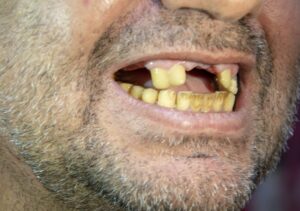
For nonsmokers who are victims of secondhand smoke, that’s a tough statistic to accept.
Just how harmful is secondhand smoke? British researchers recently released some interesting findings along these lines. Their studies included several major countries and tracked nearly 7,000 adults, with nearly half being exposed to secondhand smoke. The findings showed that breathing in the smoke of another person’s cigarette can increase the risk of oral cancer by more than 50 percent. These cancers include lip, mouth and throat cancers.
On average, smokers die 10 years earlier than nonsmokers. For every person who dies because of smoking, at least 30 people live with a serious illness related to smoking. Smoking leads to disease and disability and harms nearly every organ of the body.
When considering the mouth, smoking can create costly problems in addition to a higher risk of tooth loss.
Twenty years of research shows that cigarette smoking is a risk factor for periodontitis. A smoker is 2 – 3 times as likely to develop periodontitis, which is an advanced stage of gum disease. In addition to increased prevalence, smokers also experience greater severity of gum disease.
Nicotine (in any form) has been shown to reduce blood flow in the gum tissues in the mouth. Pipe smoking can be worse than cigarettes due to the higher temperatures generated in the upper jaw. When it comes to dental implants, smoking is a risk factor for failure. It is also detrimental for conventional bridgework.
Cigarette smoking has long been associated with serious oral conditions, including periodontal (gum) disease, bone loss, tissue loss, and tooth loss. For smokers who opt for dental implants to replace missing teeth, they have a higher risk of peri-implantitis, which is inflammation of the soft and hard gum tissues surrounding a dental implant. To no surprise, smokers have a higher incidence of dental implant failure.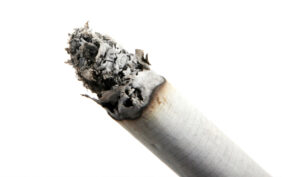
In an article published by the Journal of International’s Society of Preventive & Community Dentistry as far back as 2012, it warned that smoking can impact the rate of dental implant success, accounting for up to 20 percent of failures.
“Clinical trials of endosseous implants consistently rate smoking as a primary patient-centered risk factor for implant loss.”
https://www.ncbi.nlm.nih.gov/pmc/articles/PMC3894084/
It is common knowledge that the nicotine in cigarettes, e-cigs and ‘chew’ is an addictive drug. Some concerning quotes shared by the Oral Cancer Foundation are:
“Scientists have found that nicotine is as addictive as heroin, cocaine or amphetamines, and for most people, more addictive than alcohol,” states the article “Nicotine, Harder to Kick than Heroin,” published in the New York Times Magazine.
“Nicotine is similar in all critical measures to prototypic drugs of abuse such as cocaine, morphine and heroin.”
“Nicotine is a poison used as an insecticide.”
https://oralcancerfoundation.org/understanding/tobacco/tobacco-and-addiction/
Now, knowing the effects of secondhand smoke are likened to the non-smoking “victim” as inhaling half as many cigarettes as the user they live or work with, smokers should consider their habit in a different light.
While our Asheville periodontal dental office does not lecture or “guilt” our patients in any way, we feel they deserve to know the hazards of any risk factor related to the well being of their oral health. Without a doubt, smoking (whether cigarettes or vaping) is harmful to oral tissues and the potential to keep natural teeth.
In a report shared by Delta Dental, smokers are about twice as likely to lose their teeth than non-smokers, according to two 30-year studies at Tufts University in Boston. Their findings showed that men who smoke lose about 3 teeth for every 10 years of smoking, with women losing an average of 1.5 teeth per decade.
https://www.deltadentalins.com/oral_health/teethinpack.html
Every year, about half of smokers make some attempt at kicking the habit. Yet, only 6 or so percent are fully successful. All the while, the tobacco industry spends BILLIONS of dollars each year on cigarette and smokeless tobacco advertising and promotions.
According to the Centers for Disease Control & Prevention (CDC), in 2018 “$9.06 billion was spent on advertising and promotion of cigarettes and smokeless tobacco combined—about $25 million every day.” That’s more than $1 million dollars spent every hour of every day.
https://www.cdc.gov/tobacco/data_statistics/fact_sheets/economics/econ_facts/index.htm
While nicotine addiction means big money to the tobacco industry, it is enormously costly to our population. Now, knowing that secondhand smoke is so harmful to others, I hope our smoker patients will welcome our respectful support in their efforts to quit as we help them to maintain good oral health and keep their teeth (or dental implants) healthy for a lifetime of confident smiles.
If you’ve considered dental implants to replace missing teeth and smoke, please consult with us to discuss ways we can help you minimize the potential for dental implant failure. We want you to reap the benefits of a smile you’ll want to share proudly.
Call 828-274-9440 to schedule.
Your Tongue Is A Multi-Tasker!
Posted on May 05, 2021 by William J. Claiborne, DDS MS
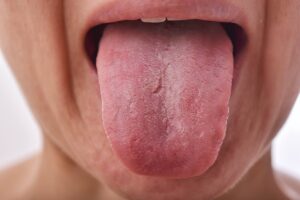 With the tongue occupying such a large area inside the mouth (or ‘oral cavity’), you’d think its anatomy would be common knowledge. Because this muscle functions continually without tiring, it tends to be taken for granted. It’s importance to your overall health, however, is unbounded.
With the tongue occupying such a large area inside the mouth (or ‘oral cavity’), you’d think its anatomy would be common knowledge. Because this muscle functions continually without tiring, it tends to be taken for granted. It’s importance to your overall health, however, is unbounded.
To correct a common misconception about the tongue, it is not the strongest muscle in the body. Although it ranks in the top 5 or so, the muscles surrounding the eyes actually have that supremacy. The heart, deemed the hardest working muscle in the body, and the masseter (jaw muscle) are also among those that are the body’s stand-outs.
The tongue does many things. It provides our sense of taste, is vital in pronunciation, moves food around as we chew, and aids in swallowing while helping to prevent certain things from being swallowed.
Not one muscle but a combination of 8, the tongue is coated with papillae. These are the tiny, bumpy protrusions on its surface. They help in various ways but are mostly credited for our sense of taste.
Different areas of the tongue are more sensitive to certain tastes. For example, the tip of the tongue detects sweet to the greatest extent while the sides detect sour. 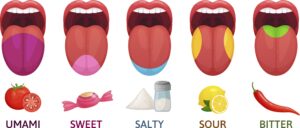
Papillae also sense touch so that we can feel the form and texture of food.
Saliva helps to keep the tongue moist so it can move around the oral cavity freely. Saliva is also helpful to the tongue by moving bacteria from its surface. However, saliva cannot keep the tongue bacteria-free.
Saliva and food residue can get stuck in the grooves between the papillae, especially on the last third of the tongue. This can create areas for bacterial growth. These bacteria thrive on remains of protein-rich food like fish, cheese or milk.
Here is where, as an Asheville periodontist, I have a particular interest in the tongue. As bacteria accumulate, a whitish film covers the tongue, which also causes bad breath. Keeping bacteria in the mouth to manageable levels is greatly supported by saliva flow.
The tongue’s underside covers two salivary glands of the lower jaw (submandibular glands). These ducts are located where the tongue meets the floor of the mouth.
If you’ve read some of my previous articles, you’ll recall that I’m constantly reminding readers of the hazards of having a dry mouth. Smoking, consumption of alcohol and caffeine, and many medications are all obstacles to the salivary glands being able to function efficiently.
A dry mouth provides a breeding ground for bacteria reproduction. When you consider the amount of bacteria embedded in the tongue’s surface, oral bacteria levels in the mouth can run rampant.
Because the tongue’s surface color can indicate too much oral bacteria, it should be looked at during at-home oral hygiene regimens. It is advised that, after brushing teeth, using the toothbrush to brush the tongue. This can dislodge an enormous amount of bacteria.
Although brushing the tongue tends to be done on the front area, it’s helpful to brush towards the back of the tongue where most bacteria exist (hence, the whiter color and smoother surface). Gagging will stop you from going too far so use that as a guide.
Some toothbrushes have a tongue scraper surface on the back side of the bristles. There are also tongue scrapers available for purchase. These are flexible strips that should be used to scrape from back to front 3 or more times after brushing. Rinsing the scraper is advised after each pass.
To provide even more support in helping the oral cavity control bacteria, an oral rinse can be very helpful. After brushing (for a minimum of 2 minutes) and flossing, swish for 30 or more seconds with an alcohol-free mouthwash. While the intensity of the mouthwash may be greater with initial use, most people notice its easier to swish around the mouth within a week or so.
Low bacteria levels in the mouth make for fresh breath and reduced risk of developing cavities and gum disease. Periodontal disease begins with gingivitis, which causes gum tissues to be tender and bleed when brushing.
Periodontitis, an advanced stage of gum disease, causes red, sore, spongy gums. Other symptoms are persistent bad breath, bleeding easily, gums that loosen from the base of teeth, and teeth that loosen.
Periodontitis can also cause health risks far beyond the mouth. Because these infectious bacteria can enter the bloodstream through tears in the gum tissues, it has been shown to trigger or worsen the development of serious health problems. Some of these are stroke, heart disease, arthritis, Alzheimer’s disease, some cancers, and diabetes.
When it comes to the tongue, remember its important role to your oral and overall health. Keep the mouth moist and its surface clean and your reward will be sweet (without the calories!).
If you are experiencing any signs of gum disease, call 828-274-9440 for an appointment. Gum disease does not go away on its own and will progressive worsen without treatment. Remember – it is the number one cause of adult tooth loss in the U.S.
Flossing – A Valuable Step In Avoiding Gum Disease & Tooth Loss
Posted on Mar 17, 2021 by William J. Claiborne, DDS MS
Adults who wish to stay healthy and active as they age often workout daily, walk at least 30 minutes per day, try to get 7 – 8 hours of sleep each night, and brush their teeth twice a day.
Tooth brushing helps to keep oral bacteria levels in the mouth to manageable levels. With the help of saliva, which is a rinsing agent for the mouth, these bacteria are generally kept under control. By preventing rampant growth, the ‘oral cavity’ (interior of the mouth) is able to avoid a destructive onslaught caused by these icky organisms.
A study shared by Dental Dental showed that about 70 percent of American adults brush their teeth twice a day. Unfortunately, this leaves more than a fourth of adults who do not.
Daily flossing is also recommended by the American Dental Association (ADA) as a preventative way to keep cavities and gum disease at bay. Still, an estimated 30 percent are committed to daily flossing – less than a third.
This means that a whopping 70 percent do not include flossing in their daily oral hygiene regimens. Too, about a third of Americans admit to never flossing, with 39 percent of men and 27 percent of women who do not.
Yet, the devotion of twice daily brushing and daily flossing requires only about 5 minutes of time – total. It is recommended to spend two minutes brushing teeth in the morning and before bed. A practiced flosser requires about a minute to floss. (Consider that five minutes is about the amount of time for a commercial break between TV programs.)
Yet, if you could see what I see…
As a periodontist, my specialty includes advanced training in the treatment of gum disease. I know the destructive nature of infectious oral bacteria. I have a bird’s eye view of what can occur without a committed oral hygiene routine at home. When an overload of bacteria accumulate in the mouth, cavities are able to form and gum tissues become food for living and breeding bacteria.
While brushing twice a day is important, the bristles of a toothbrush are typically unable to dislodge food particles caught between teeth. Left behind, these particles begin to rot rather quickly, leaving even more sustenance for bacterial growth and reproduction.
To see just how much your toothbrush misses, brush your teeth thoroughly for the recommended two minutes at the end of the day. Rinse and spit a couple of times. Then, using a strand of floss, move gently between teeth, easing up and down to reach the sides of all teeth. Move the floss just slightly beneath the gums at the base of each tooth. After all teeth are flossed, rinse and spit again. Most people are shocked at just how much their toothbrush failed to remove.
When oral bacteria amass past the point that is manageable by the immune system, these bacteria become infectious. This causes inflammation in the gum tissues, which can lead to the formation of periodontal (gum) disease. This begins with gingivitis, which has mild symptoms. Untreated, it worsens to periodontal disease and the advanced level of periodontitis.
It begins when oral bacteria accumulation creates a sticky film in the mouth known as plaque. When not removed thoroughly and frequently, plaque can form cement-hard bacteria colonies that attach to teeth. This hardened form of bacteria is known as tartar and, once formed, can no longer be brushed or flossed away.
As a Periodontist, I often see people who have developed periodontal disease who come (or have been referred) because they have obvious symptoms, such as red, swollen gums. However, I also see patients who are surprised to learn they have developed the disease. Yet, even without obvious symptoms, gum disease may exist and be fully underway.
Nearly half of American adults have some level of gum disease (over 47 percent in recent estimates). Periodontal (gum) disease is the nation’s leading cause of adult tooth loss even though it’s one of the most preventable of all diseases with simple measures.
Losing natural teeth leaves an individual with having to make decisions for replacement – crown-&-bridge combination, partial denture, full denture or Dental Implant. These time-consuming procedures and expenses can be avoided. And, contrary to what many believe, losing teeth is not a natural part of the aging process. With proper care, you can easily enjoy a smile of natural teeth all your life.
It is often surprising to people to learn that oral health is an integral part of overall health. Inflammation in the mouth doesn’t simply remain in the mouth. Through tears in diseased gum tissues, the oral bacteria of gum disease are able to enter the bloodstream. As the bacteria travel throughout the body, their toxic nature can activate inflammatory effects elsewhere.
Infectious gum disease bacteria have been the focus of a numerous amount of research over the years. Studies have found that the bacteria of gum disease can trigger or worsen heart disease, stroke, preterm babies, arthritis, diabetes, some cancers, Alzheimer’s disease, erectile dysfunction (ED) and impotency. As research continues, even more serious (and deadly) connections are being made.
They key is to keep oral bacteria levels to a minimum, which is why brushing and flossing are an important part of your daily care routine. Neither step should be taken for granted. Yet, as a periodontal specialist, I understand how it can be difficult to get into the habit of daily flossing.
For some, the tight floss around fingers is uncomfortable. For others who have large fingers or problems with manual dexterity, the act of flossing is awkward or challenging. However, for those who floss on a daily basis, it becomes a maneuver that is as simple as brushing teeth.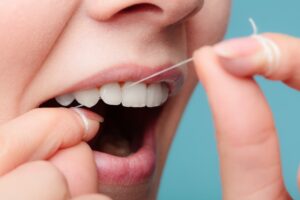
For individuals who are challenged by manual flossing, there are some excellent water flossers on the market. These are affordable and can be just as effective as ‘string’ flossing when used properly – and daily.
Twice daily brushing (at least two minutes per time), daily flossing, drinking ample water and limiting sweets and caffeine are simple ways to keep your mouth healthy between regular dental check-ups and cleanings. And, those 6-month check-ups are important. During these visits, tartar that may have formed can be removed and signs of early gum disease can be addressed.
If you are experiencing symptoms of gum disease, call 828-274-9440. In our state-of-the-art Asheville periodontal dental office, our patients are treated with respect, compassion and a gentle touch. Here, you’ll never be lectured. Our goal is to restore your smile to a healthy state and develop a program to help you keep it at its best.
New patients are always welcome. A referral is not needed to become a patient.
Bad Breath – The “Body Odor” of the Mouth.
Posted on Mar 09, 2021 by William J. Claiborne, DDS MS
“Whoa!!!”
That may be our unspoken reaction when we encounter someone who’s breath odor reeks. And, we’ve all encountered it. It tends to leave a rather negative impression of the individual; one that ‘sticks’ with us every time we see him or her in the future.
Occasionally, I like to address the causes of bad breath since, at one time or another, it’s an issue for us all. Bad breath, like body odor, leaves an undesirable imprint.
Although some health conditions can be the source of bad breath, it most commonly occurs due to an overload of oral bacteria. Too many bacteria in the mouth create an odor — a sulfuric, putrid odor.
Bacteria are living organisms that eat, reproduce and emit waste. Their ability to reproduce is astounding, resulting in a consistently growing number of waste-producing creatures.
Poor oral hygiene is the most common cause for bad breath. Not brushing and flossing or doing so adequately allows oral bacteria to reproduce, which leads to plaque.
Plaque is the sticky film you feel on teeth when you’ve missed brushing or when you wake up. When not removed thoroughly on a daily basis, plaque turns into a cement-hard substance known as tartar. This mass is actually a solid colony of oral bacteria that attaches to teeth. In this form, it cannot be brushed or flossed away.
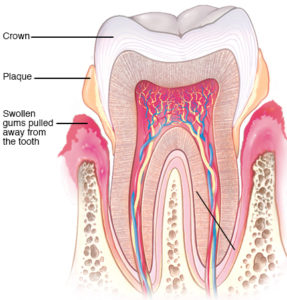 Tartar attacks enamel and gum tissues. As bacteria multiplies, it causes the gum tissues to become inflamed. This inflammation can quickly develop into gingivitis, an early form of gum disease. If not resolved fully, however, gingivitis can lead to full-blown periodontal (gum) disease.
Tartar attacks enamel and gum tissues. As bacteria multiplies, it causes the gum tissues to become inflamed. This inflammation can quickly develop into gingivitis, an early form of gum disease. If not resolved fully, however, gingivitis can lead to full-blown periodontal (gum) disease.
Occasional bad breath is a nuisance but can generally be controlled with good oral hygiene, keeping our mouth moist and limiting sugar. Things like drinking sugary colas and a diet of high carbohydrate foods rev up bacteria reproduction even more, boosting their ability to grow and thrive.
However, frequent bad breath is not only embarrassing, it is a warning sign.
As one of the symptoms of periodontal (gum) disease, persistent bad breath may be accompanied by tender gums that bleed easily when brushing or tender, swollen areas around some teeth.
As gum disease advances, symptoms include gums that turn red in color and become sore, swollen and bleed easily when brushing. As it worsens, bad breath becomes persistent. Pus-filled pockets may develop near the base of some teeth. Eventually, teeth may loosen and require removal.
While what we consume can greatly contribute to the ability of these icky organisms’ ability to reproduce, a common one is having a dry mouth. This condition is known as xerostomia (zeer-o-STOE-me-uh).
Good saliva flow helps to keep bacteria moving out of the mouth. However, when brushing is infrequent or the mouth becomes dry, saliva is less able to manage the bacteria levels in the mouth.
A dry mouth may seem less likely to be a breeding ground for bacteria since they typically thrive in environments that are warm, moist, and dark. However, when saliva flow is unable to efficiently cleanse bacteria buildup from the mouth, they are easily able to reproduce.
Having ‘dry mouth’ is rather common today. In addition to a part of the aging process, a number of common medications (including anti-depressants, decongestants, and anti-histamines) have a side effect of oral dryness.
Too, many beverages contribute to having a dry mouth. These include colas, coffee, tea, and those containing alcohol. (Please note that colas are acidic and most contain caffeine. These are anything but ‘refreshing’, doing very little to hydrate the body. Stick to plain water to quench your thirst and add moisture to the body.)
Another way that oral bacteria can run rampant has to do with our oral hygiene routines. To be truly thorough in cleaning tooth surfaces, it is recommended to spend two minutes per brushing, twice a day (whether manual or electronic).
It is estimated that nearly a third of American adults brush their teeth for an insufficient amount of time. Even worse, about that same amount fail to brush twice a day. This means that an alarming amount of bacteria remain to grow and thrive in the mouth.
Proper brushing and flossing is necessary. Brush for at least two minutes twice daily and swish thoroughly. Use a circular motion rather than scrub teeth back and forth to avoid damaging tender gum tissues. Never use a hard bristle tooth brush or brush with harsh substances such as baking soda! These can wear down tooth enamel and wear away precious gum tissue.
You may be surprised to learn that brushing only tackles about half the amount of bacteria in the mouth, leaving a tremendous amount that continue to grow and thrive. The tongue actually harbors 58 – 65 percent of the bacteria in the ‘oral cavity’.
Oral bacteria love to take up housing in the tiny bumps and grooves of the tongue since they are not easily dislodged. Thus, it’s necessary that tongue cleaning be a part of your oral hygiene regimen at home to keep bacteria levels under control.
Some toothbrushes have a “tongue scraper” on the reverse side of the bristles that’s an effective option. Or, you can brush your tongue with the bristles after your teeth are brushed. Be sure to reach towards the back of the tongue where the majority of bacteria exist.
An advantage of achieving and maintaining a clean, healthy mouth is being confident when close to others. Plus, you’ll be contributing to the health and well-being of your entire body. Research has shown that a healthy mouth is a supportive component of a healthy you!
If you are experiencing symptoms of gum disease or concerned your breath is frequently bad, call 828-274-9440. We’ll arrange a periodontal exam in our comfortable Asheville periodontal office.
Here, we are committed to the comfort of each patient as well as those who have avoided dental care in the past due to fear. Dental fear is common, and we have a reputation for a gentle touch and respectful care. We also make oral and IV sedation (twilight sleep) available.
Let’s help you establish a healthy smile and feel confident in closeness!
Recent Posts
Categories
Archives
- September 2024
- August 2024
- July 2024
- June 2024
- May 2024
- April 2024
- March 2024
- February 2024
- January 2024
- December 2023
- November 2023
- October 2023
- September 2023
- August 2023
- July 2023
- June 2023
- May 2023
- April 2023
- March 2023
- February 2023
- January 2023
- December 2022
- November 2022
- October 2022
- September 2022
- August 2022
- July 2022
- June 2022
- May 2022
- April 2022
- March 2022
- February 2022
- January 2022
- December 2021
- November 2021
- October 2021
- September 2021
- August 2021
- July 2021
- June 2021
- May 2021
- April 2021
- March 2021
- February 2021
- January 2021
- December 2020
- November 2020
- October 2020
- September 2020
- August 2020
- July 2020
- June 2020
- May 2020
- April 2020
- March 2020
- February 2020
- January 2020
- December 2019
- November 2019
- October 2019
- September 2019
- August 2019
- July 2019
- June 2019
- May 2019
- April 2019
- March 2019
- February 2019
- January 2019
- December 2018
- November 2018
- October 2018
- September 2018
- August 2018
- July 2018
- June 2018
- May 2018
- April 2018
- March 2018
- February 2018
- January 2018
- December 2017
- November 2017
- October 2017
- September 2017
- August 2017
- July 2017
- June 2017
- May 2017
- April 2017
- March 2017
- February 2017
- January 2017
- December 2016
- November 2016
- October 2016
- September 2016
- August 2016
- July 2016
- June 2016
- May 2016
- April 2016
- March 2016
- February 2016
- January 2016
- December 2015
- November 2015
- October 2015
- September 2015
- August 2015
- July 2015
- June 2015
- May 2015
- April 2015
- March 2015
- February 2015
- January 2015
- December 2014
- November 2014
- October 2014
- September 2014
- August 2014
- July 2014
- June 2014
- May 2014
- April 2014
- March 2014
- February 2014
- January 2014
- December 2013
- November 2013
- October 2013
- September 2013
- August 2013
- July 2013
- June 2013
- May 2013
- April 2013
- March 2013
- February 2013
- January 2013
- December 2012
- November 2012
- October 2012
- September 2012
- August 2012
- July 2012
- June 2012


